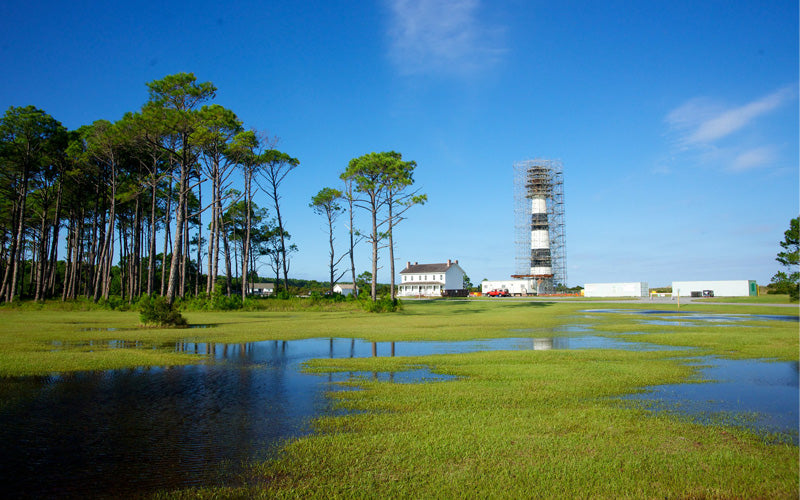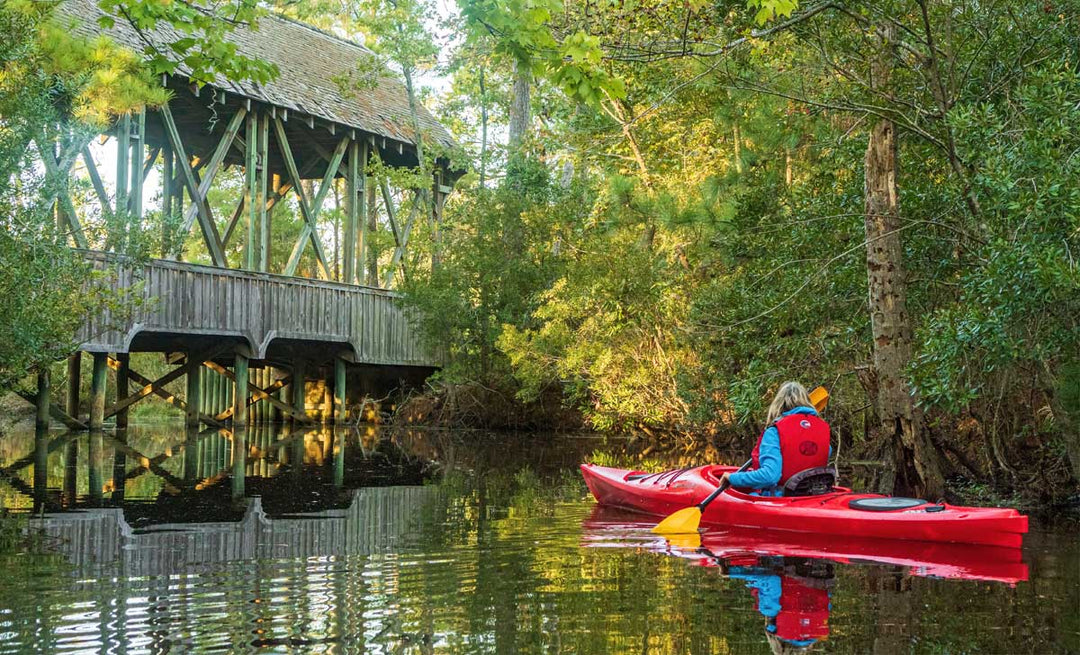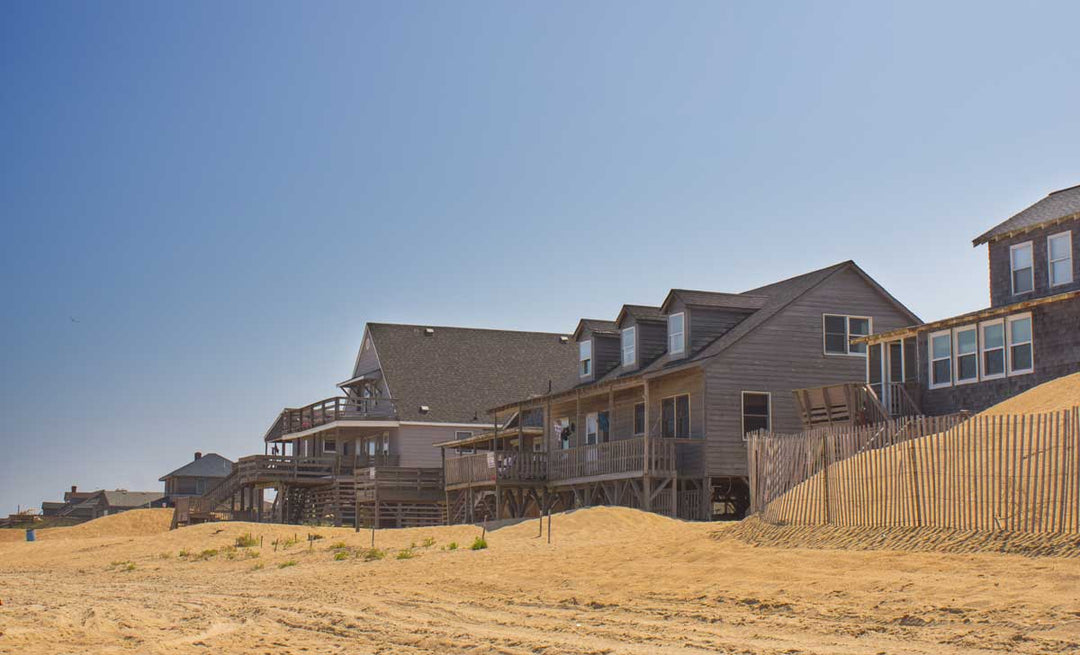Bodie Island Lighthouse on the Outer Banks NC

No question about it, North Carolina's Outer Banks is home to some world-class lighthouses including Bodie Island Lighthouse, a majestic black and white striped structure that's hard to miss while traveling from the central to southern branches of the barrier islands.
Bodie Island Lighthouse was built in 1871 - 1872 by the United States Lighthouse Board for use as a nighttime aid to navigation to help guide sailors as they traversed the treacherous waters off the coast of North Carolina.
The current structure is the third lighthouse constructed at this general location - the other two crumbled due to very different circumstances.
Since inception, the beam emitting from the top of the structure has been shining nightly to use as an aid to navigation. Even with precise satellite instruments available to those steering smaller vessels, some boat captains still rely on the black and white striped tower for assistance while approaching Oregon Inlet.
Over the years, the power source for the light changed from oil to electrical, but few other changes were made to Bodie Island Lighthouse.
Its light pattern is characterized by 2.5 seconds on, 2.5 seconds off, 2.5 seconds on, and then 22.5 seconds off.
Apart from the assistance for sailors, the structure is an important landmark for the area's tourism industry. Tens of thousands of visitors from the East Coast and Midwest stop by the National Park Service managed facility to snag a photo or two of the lighthouse.

Where is Bodie Island Lighthouse Located?
There are a total of five lighthouses along the Outer Banks. Can you name all of them?
If you have spent any amount of time vacationing on North Carolina’s Outer Banks which is commonly referred to as "OBX", then you have no doubt traveled along NC 12, or “beach road” as the locals commonly refer to it. This roadway will take you clear from Corolla to the foot of the ferry to Ocracoke Island – some 200+ miles in totality.
Travelers who head south on NC 12 from the town of Kill Devil Hills will easily be able to spot Bodie Island Lighthouse that’ll appear out of nowhere on the sound side (right side if driving south).
Once you traverse over the Bonner Bridge heading north to the central beaches, you'll spot Bodie Island Lighthouse on your left - just past Oregon Inlet Fishing Center.
8210 Bodie Island Lighthouse Road
Nags Head, NC 27959
History of Bodie Island Lighthouse
You may nor may not know this, but the current Bodie Island Lighthouse that you and I can visit today is the third that has stood in this vicinity on the Outer Banks.
Below is a brief history of the three different structures followed by a timeline to help connect the dots.
Original Bodie Island Lighthouse (1848)
In 1837, Congress appropriated $5,000 ($139,000 in today's dollars) to be used for the construction of a lighthouse on Pea Island which would aid ships as they navigate the tremulous waters directly off the coast of North Carolina that is sometimes referred to as the "Graveyard of the Atlantic."
Problems with the location and design of the lighthouse resulted in a ten-year delay in construction. A resident of Baltimore, MD named Mr. Francis Gibbons was the head contractor responsible for overseeing the construction of the first version of Bodie Island Lighthouse which began in 1847 and was completed the following year. The final cost of the construction of the lighthouse was $8,750.
The structure consisted of a brick tower that was 54-feet high and crowned with a lantern 10 feet in diameter. In addition, a home for one lighthouse keeper was built out of wood as well as a brick cistern and two outhouses.
Soon after the tower was completed, it was apparent something was amiss as the lighthouse began to lean to one side. Apparently, the foundation had not been designed to accommodate the soils upon which the structure had been built, causing it to settle unevenly. Yikes!
The lighthouse used not a Fresnel lens-like its future versions, but instead, a revolving lighting apparatus made up of fourteen lamps and reflectors that frequently did not operate as intended.
In 1859, only ten years after being constructed, Bodie Island Lighthouse had deteriorated so much that it had to be condemned.
Although this project was overall a failure, Mr. Gibbons learned much from this project and would later become a prominent lighthouse builder on the West Coast of the United States.
Even if the lighthouse hadn't fallen to pieces soon after being constructed, the original would be underwater as the structure was located south of Oregon Inlet on Pea Island in an area that has experienced a significant amount of beach erosion over the years.
Second Go Around (1859)
Following the decommissioning of the first lighthouse, a $25,000 appropriation ($720,805 in today's dollars) from Congress was obtained to be used towards the construction of a new tower.
During this go-around, the Army Corps of Engineers was tasked with designing and overseeing the construction of the new Bodie Island Lighthouse. The 80-foot-tall structure was completed in 1859 using a third-order Fresnel lens that required two operators to function. On a clear night, the new lens was capable of emitting light into the Atlantic and could be seen up to 15-miles from the shoreline.
Unfortunately soon after construction was completed in the midst of the Civil War, Confederate troops stacked explosives inside the tower and blew it to smithereens during the autumn of 1861.
Third and Current Structure (1871)
In 1871, construction on a third Bodie Island Lighthouse was completed. This structure stands tall today at 156 feet (48m) and utilizes a first-order Fresnel lens a set of 344 glass prisms configured into an oval case 12 feet tall and 6 feet wide. Magnified by the lens, the 1,000-watt bulb is visible nearly 20 miles from the shoreline.
The lens was installed in September, and the light was first exhibited on October 1, 1872. The total cost for the Light Station was $140,000 - more than 46 times the cost of the original Lighthouse and more than 5 times the cost of the second.
Between 1872 and 1940, four Principal Keepers served the Bodie Island Light Station. Decades later in 1932, Bodie Island Lighthouse became automated and the light was upgraded to an electric lamp by using oil-fueled electrical generators. Not long after, care for the lighthouse was transferred to the National Park Service (NPS) in 1953 and generators were disconnected and power began being supplied from the commercial electric grid.
Bodie Island Lighthouse Timeline
- 1837 - Congress appropriates funds for the construction of a lighthouse.
- 1848 - Completion of the first Bodie Island Lighthouse.
- 1859 - The first Bodie Island Lighthouse was condemned and completion of the second Bodie Island Lighthouse was completed in just a year.
- 1861 - Start of the Civil War. Confederates occupy Bodie Island Lighthouse. Confederates abandon Bodie Island Lighthouse to the Union troops but blow it up after removing the light, preventing the northerners from utilizing it.
- 1871 - The US government purchased land from John B. Etheridge and his wife for the location of a new Bodie Island Lighthouse.
- 1872 - Light of third Bodie Island Lighthouse first exhibited. The original oil source was lard oil. William F. Hatsel was employed as the first Keeper of the Bodie Island Light.
- 1883 - The Lighthouse Board substitutes mineral oil (kerosene) as the fuel source for the light.
- 1884 - Regular mineral oil lamps were installed in the light. New lightning protection installed.
- 1898 - Telephone service was installed at the lighthouse.
- 1912 - Light upgraded to a vapor oil lamp.
- 1932 - Lighting apparatus converted to electricity. Generator installed in the former Oil Room of the Oil House. Light converted from a fixed to a flashing light. Candlepower jumps to 160,000.
- 1934 - Tower scraped and painted.
- 1937 - Cape Hatteras National Seashore was established.
- 1939 - United States Coast Guard assumes control of the lighthouse.
- 1940 - Bodie Island Lighthouse becomes an unmanned light.
- 1941 - Candlepower of light reduced from 160,000 to 13,000.
- 1945 - The size of Bodie Island Lighthouse site increased from 15 acres to a little over 56 acres.
- 1953 - Lighthouse tower cleaned and re-painted. Electrical source converted from generator to commercial power. The existing generator is used for emergency power only.
- 1953 - Bodie Island Light Station property (56.37 acres) declared surplus and transferred to the care of the National Park Service, except for the small, square plot of land, 100’ on a side, on which the Lighthouse stands.
- 1959 - Lighthouse tower re-painted.
- 1963 - Candlepower increased to 80,000. Tower and Oil House painted.
- 1969 - The timing device controlling the light was replaced with a photoelectric cell.
- 1978 - Lighthouse tower and oil house painted.
- 1987 – Once again, the lighthouse tower was painted.
- 1988 - The National Park Service and the United States Coast Guard jointly commemorate the establishment of the Lighthouse Service by escorting visitors to the top of the lighthouse.
- 1994 - Outer Banks Lighthouse Society was established.
- 1997 - Tower and Oil House repaired and repainted by the United States Coast Guard.
- 2000 - Bodie Island Lighthouse officially transferred to the care of the National Park Service.
- 2013 - Following significant renovations that enhanced the ascetic appeal and structural integrity of the tower, the general public was first the first time ever allowed to climb to the top of the lighthouse via guided tours.
- 2015 - National Park Service switches from guided tours with a park ranger to self-guided tours, allowing visitors to climb at their own leisure.
Where is the name Bodie Island from?
The name is actually derived from the original name of the area, which was "Bodie's Island" after the Body family who once owned the land that was a separate barrier island prior to 1811 when Roanoke Inlet separated it from the Currituck Banks to the north closed.
Some people say that the name was derived from the many bodies that washed ashore from centuries of shipwrecks off the coast of North Carolina known as the Graveyard of the Atlantic. This is only a farce though.
When talking about the Outer Banks landmark, don't make the mistake when reciting its name.
Bodie Island is pronounced like the word “body.” It is commonly mispronounced by visitors who use a long southern “OH” – as in “BOH-die.”
Quick Facts about Bodie Island Lighthouse
|
156 |
214 |
1,000 |
- The materials used to construct Bodie Island Lighthouse include cast iron, granite, brick and stone with timber framing, and rubble masonry.
- Up until 2015, visitors were only allowed to climb Bodie Island Lighthouse with a National Park Service ranger. You can now conduct your own self-guided tour - tickets are still required!
- In order to enjoy the view from the top and tell everyone at home you conquered the climb, you'll have to hike up 214 stairs.
- Bodie Island Lighthouse is one of the few lighthouses with an original, first-order Fresnel lens in the United States.
- Towering 156-feet from the ground, climbing the Bodie Island Lighthouse is equivalent to climbing a 10-story building.
- Currituck Beach Lighthouse in Corolla, NC was built using a similar blueprint to Bodie Island Lighthouse. Although a similar design, the two towers look very different as Bodie Island is painted and Currituck Beach is not.
- Be wary of snakes! You'll see some signage when you visit. Anywhere from 3 to 19 timber rattlesnakes are spotted at Bodie Island Lighthouse in a given season.
- About 25,000 people climb to the top of the lighthouse annually.
- Since 2000, the National Park Service (NPS) has managed Bodie Island Lighthouse. The staff consists of mostly seasonal employees and varies greatly from season to season - most workers are only there for one summer. As part of orientation, short-term employees are required to learn a great deal about the history of Bodie Island Lighthouse.
Want more? Check out: 17 Facts About Bodie Island Lighthouse

Recent Renovations to Bodie Island Lighthouse
Following a $5 million dollar renovation that began in August of 2009, Bodie Island Lighthouse became open for climbing to the public for the first time ever in March of 2013.
Multi-year renovations include replacing many of the old stair steps and reinforcing the metal supports under the lens and balcony as well as repainting the exterior of the structure.
How to Climb Bodie Island Lighthouse
Visitors have the opportunity to traverse the spiral staircase inside the lighthouse to the top at their own pace - each tour is unguided. There is typically an NPS ranger at the top and bottom of the lighthouse to provide help if need be.
Climbing Bodie Island Lighthouse is possible from the third Friday in April through Columbus Day (in early October).
Please note that tickets are required to climb!
Climbing tickets are $10 for adults and $5 for senior citizens (62 or older), children 11 years of age and under as well as those who are disabled.
Climb tickets are available on a first-come, first-served basis and can only be purchased in person at the site the day of the climb. There are no advance ticket sales for regular climbs.
Ticket sales begin at 9 am, with climb times running every 20 minutes with a limit of eight visitors per climb. The last climb takes place at 4:30 pm. Ticket holders should arrive at the base of the lighthouse five minutes prior to their ticketed climb time.
Climbing rules and regulations:
- Each and every climber must be at least 42" inches tall and physically fit enough to climb all the steps on his/her own.
- Children that are 11 years of age or younger must be accompanied by an adult who is at least 16 years of age or older.
- There is only one person at a time allowed on each flight of stairs to help protect the structural integrity of the lighthouse.
- Running, jumping, or stomping on the lighthouse stairs and landings is strictly prohibited.
- Please no eating, drinking (with the exception of water), or smoking inside the lighthouse.
- Each climber must weigh less than 260 lbs in order to climb.
- There are no pets allowed inside the lighthouse.
- Everyone ascending the lighthouse must be wearing shoes - no bare feet or high heels are permitted.
- Do NOT under any circumstance toss an object off the railing at the top of the lighthouse as it could result in serious injury to someone below.
How many visitors climb to the top of Bodie Island Lighthouse each year?
We created the table below using data from the Official Tourism Authority for Dare County’s Outer Banks.
Note that these are statistics for climbers only; the number of individuals just stopping in to snag a photo of Bodie Island Lighthouse is much higher!
| 2017 | 2018 | 2019 | |
| Jan | Closed | Closed | Closed |
| Feb | Closed | Closed | Closed |
| Mar | Closed | Closed | Closed |
| Apr | 1,133 | 1,617 | 2,035 |
| May | 4,570 | 2,959 | 5,009 |
| June | 5,287 | 5,006 | 5,355 |
| July | 5,009 | 5,428 | 4,458 |
| Aug | 5,025 | 5,390 | 5,201 |
| Sept | 4,454 | 3,464 | 3,644 |
| Oct | 1,326 | 1,251 | 2,264 |
| Nov | Closed | Closed | Closed |
| Dec | Closed | Closed | Closed |
| Totals | 25,478 | 23,864 | 25,702 |
Visitors Center Details
The onsite visitor center is a great place to get oriented, purchase lighthouse tour tickets, and browse the bookstore. The visitors center and grounds are open year-round with the exception of Christmas Day. There is no admission fee to browse the center or park.
While visiting, you may want to take a stroll along the nearby boardwalk that continues past the lighthouse to a wildlife observation deck on the edge of a freshwater pond where you can peacefully observe area waterfowl and wading birds. This boardwalk offers an excellent view of a freshwater marsh and is the perfect locale to snag a photo for your social media profile.
Bodie Island Lighthouse Merchandise
Want to show off your love for Bodie Island Lighthouse?
We worked with a top-notch designer to bring our fans a t-shirt design that's sure to please! Hand-drawn by an ultra-talented artist, our Bodie Island Lighthouse t-shirt has been well-received by our fans. We're pretty sure you'll appreciate it as well!
As with all of our merchandise, this design is only available online on our website. Order today and snag a photo or two in front of this Outer Banks landmark during your next visit to these beloved barrier islands.






